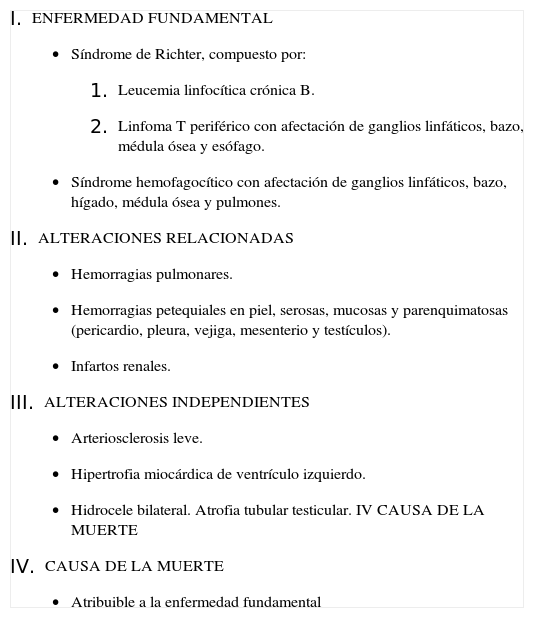El síndrome hemofagocítico (SH) es un padecimiento poco frecuente, de etiología multifactorial, descrito, en sus formas secundarias, asociado a linfomas T, inmunosupresión medicamentosa, concretamente fludarabina, y a infecciones por virus, especialmente virus de Epstein-Barr (VEB). La evolución de la leucemia linfoide crónica (LLC) a linfomas más agresivos no es rara, se llama síndrome de Richter (SR), y se asocia ocasionalmente al VEB.
Material y MétodosSe realiza la autopsia de un varón de 63 años diagnosticado de LLC, estable durante años, que recae y, tras varios ciclos de quimioterapia, desarrolla una insuficiencia medular intensa que evoluciona hacia el éxitus tras fracaso multiorgánico.
ResultadosEl estudio macroscópico muestra datos inespecíficos. El estudio histológico revela un SH asociado a un síndrome linfoproliferativo complejo que presenta dos patrones mezclados, con predominio en ganglios y bazo del menos diferenciado, constituido por células grandes con inmunofenotipo T, y en otros órganos con persistencia del patrón linfoide de células pequeñas B consistente con el diagnóstico primitivo. El estudio inmunohistoquímico es negativo para VEB en las células tumorales.
ConclusionesLa asociación de SH a Síndrome de Richter como tal no está recogida en la literatura revisada. Descartada la etiología vírica, quedan como posibles etiologías del SH el linfoma T desarrollado sobre la inicial LLC, que justifica el empeoramiento final del enfermo sin respuesta a los fármacos, o el uso de fludarabina y, subsecuentemente, insuficiencia medular final asociada al SH.
The haemophagocytic syndrome (HS) is a rare disease of multifactorial aetiology, which has been described in its secondary forms associated to T-cell lymphomas, drug induced immunsupression, concretely with Fludararabine, and in other cases to virus infection, especially with the Epstein-Barr-Virus (EBV). The evolution of chronic lymphatic leukaemia (CLL) to more aggressive lymphomas is not unusual and it is known as Richter's Syndrome (RS), also occasionally associated to EBV.
Material and methodsAutopsy of male, 63 years old, with diagnosis of CLL, stable for years, relapsing, and after various cycles of chemotherapy develops a medullar insufficiency which leads to death after multiorganic failure.
ResultsThe macroscopic study reveals non-specific signs. The histological study reveals a HS associated to a complex lymphoproliferative syndrome with two patterns predominating in lymph nodes and spleen, the less differentiated formed of large cells with T-immunophenotype and in other organs persistence of the lymphoid pattern of small B-cells in accordance with the primitive diagnosis. The immunohistochemical study does not reveal positivity for EBV in tumour-cells.
ConclusionsThe association of HS to RS is not described in the revised literature. Being negative the EBV, other possible aetiologies of the HS are the T-cell lymphoma developed on the initial CLL which justifies the final worsening without drug-response or the application of Fludarabine after which the patient develops the final medullar insufficiency associated to the HS.
Artículo
Comprando el artículo el PDF del mismo podrá ser descargado
Precio 19,34 €
Comprar ahora













